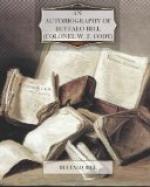While at the Agency I learned that the Indian I had killed in the morning was none other than Yellow Hand, a son of old Cut Nose, who was a leading chief of the Cheyennes. The old man learned from the members of Yellow Hand’s party that I had killed his son, and sent a white interpreter to me offering four mules in exchange for the young chief’s war-bonnet. This request I was obliged to refuse, as I wanted it as a trophy of the first expedition to avenge the death of Custer and his men.
The next morning we started to join the command of General Crook, which was encamped at the foot of Cloud Peak in the Big Horn Mountains. They had decided to await the arrival of the Fifth Cavalry before proceeding against the Sioux, who were somewhere near the head of the Big Horn River, in a country that was as nearly inaccessible as any of the Western fastnesses. By making rapid marches we reached Crook’s camp on Goose Creek about the third of August.
At this camp I met many of my old friends, among them being Colonel Royal, who had just received his promotion to a lieutenant-colonelcy. Royal introduced me to General Crook, whom I had never met before, but with whose reputation as an Indian fighter I was of course familiar, as was everybody in the West. The general’s chief guide was Frank Grouard, a half-breed, who had lived six years with Sitting Bull himself, and who was thoroughly familiar with the Sioux and their country.
After one day in camp the whole command pulled out for Tongue River, leaving the wagons behind. Our supplies were carried by a big pack-train. Down the Tongue we marched for two days of hard going, thence westerly to the Rosebud River. Here we struck the main Indian trail leading down-stream. From the size of this trail, which was not more than four days old, we estimated that at least seven thousand Indians, one of the biggest Indian armies ever gathered together, must have gone that way. It was here that we were overtaken by Captain Jack Crawford, widely known East and West as “The Poet Scout.” Crawford had just heard of the Custer massacre, and had written a very creditable poem upon receipt of the news. His pen was always ready, and he made many epics of the West, many of which are still popular throughout the country.
Jack was a tenderfoot at that time, having lately come to that country. But he had abundant pluck and courage. He had just brought dispatches to Crook from Fort Fetterman, riding more than three hundred miles through a country literally alive with hostile Indians. These dispatches notified Crook that General Terry was to operate with a large command south of the Yellowstone, and that the two commands would probably consolidate somewhere on the Rosebud. On learning that I was with Crook, Crawford at once hunted me up, and gave me a letter from General Sheridan, announcing his appointment as a scout. He also informed me that he had brought me a present from General Jones, of Cheyenne.




